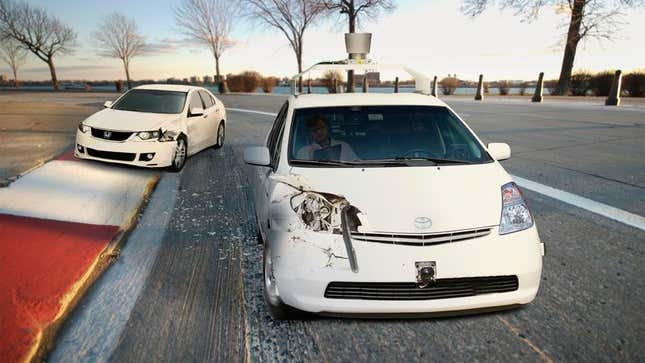
PLANO, TX—Describing the prototype as a major technological breakthrough for autonomous vehicles, engineers at Toyota unveiled the first driverless car Thursday capable of committing a hit-and-run.
Members of the design team told reporters that the innovative autonomous car, which relies on a system of sensors and sophisticated algorithms to provide it with a split-second reaction after being involved in a collision, has successfully demonstrated the capacity to immediately flee the scene of an accident to avoid legal repercussions without any human intervention.
“With this step forward, we are closer than ever to having road-ready self-driving cars that are proficient at assessing vehicular damage, analyzing surroundings, and performing complex maneuvers to effectively dodge responsibility after clipping another automobile,” said head engineer Stephen Graham, adding that throughout numerous crash tests on a closed course, the driverless car perfectly executed evasive actions to frantically peel away before observers could record the license plate number. “Very soon, there could be a fleet of self-driving cars specifically designed to eliminate the possibility of human error when making a break for it following a fender bender.”
“Taking your hands off the wheel and allowing your car to respond to an accident by squealing out of the area as fast as possible is the future of automotive transport,” Graham continued.
“The day it finally left a huge dent in the side panel of another vehicle and just tore out of the parking lot in under three seconds, that’s when we knew we were onto something.”
According to engineers, the driverless car features an advanced Culpability-Evasion System, which rapidly utilizes front, side, and rear-mounted cameras to determine whether the other vehicle involved in the collision sustained any visible scrapes or dents and survey the area for eyewitnesses. Technicians confirmed that the self-driving vehicle’s onboard computer calculates within several microseconds of the crash if its own actions are to blame, and if it finds it is at fault, it then initiates a strategy to floor it and speed onto a major roadway before the police arrive.
Saying the vehicle’s automated hit-and-run ability represented the culmination of years of effort, Toyota sources explained that the car had experienced a number of setbacks in early development, including its repeated failure to desert the scene of even small dings, scratches, and rear-end impacts.
“Our earliest tests involved closely controlled scenarios such as having the driverless car back into a parked minivan, but they always failed immediately when the vehicle would mistakenly put on its hazard lights and wait for the other driver to return,” said computer programmer Claire Durmont, adding that they eventually tweaked the algorithms so the vehicle would immediately drive off after colliding with another automobile or with a stationary object such as a pole or mailbox. “The day it finally left a huge dent in the side panel of another vehicle and just tore out of the parking lot in under three seconds, that’s when we knew we were onto something.”
“Now, it has the ability to put some distance between itself and the crash site by driving for 25 straight miles in any direction before it finally pulls over into a fast food place parking spot to gather its composure,” continued Durmont.
Although those involved with the project admitted that the car’s hit-and-run abilities are still rudimentary, they stressed that once the autonomous system is fine-tuned, future models will be capable of far outperforming humans in escaping any and all responsibility for an accident.
“This vehicle’s onboard computer can instantaneously make judgment calls, like whether that nick in the sports car it just struck was already there, with an incredible level of accuracy,” said David Conroy, an automotive consultant on the project. “Autonomous cars are all about making life easier for the vehicle’s occupants. And by using real-time satellite imagery and up-to-the-second traffic data to flee the scene of an accident far faster than any human driver could, our self-driving vehicle will remove any chance of having to deal with costly traffic citations, insurance rate hikes, or the irate owner of the damaged vehicle, taking all the hassle out of driving.”
Added Conroy, “This is what driving should be.”
Hoping to build on their initial success, Toyota engineers confirmed they were very close to programing the self-driving car to aggressively pursue an asshole motorist who cuts it off in traffic.